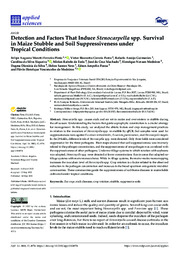Detection and factors that induce Stenocarpella spp. survival in maize stubble and soil suppressiveness under tropical conditions.
Detection and factors that induce Stenocarpella spp. survival in maize stubble and soil suppressiveness under tropical conditions.
Author(s): PINTO, F. A. M. F.; PORTO, V. B. C.; GUIMARÃES, R. A.; SIQUEIRA, C. da S.; FARIA, M. R. de; MACHADO, J. da C.; MEDEIROS, H. N.; SILVA, D. D. da; SANTOS NETO, H.; POZZA, E. A.; MEDEIROS, F. H. V. de
Summary: Stenocarpella spp. causes stalk and ear rot in maize and overwinters in stubble during the off-season. Understanding the factors that guide saprophytic colonization is a crucial strategy for management. In this study, we analyzed the abiotic factors and crop management practices in relation to the inoculum of Stenocarpella spp. in stubble by qPCR. Soil samples were used for suppressiveness tests against Fusarium verticillioides, Fusarium graminearum, and Stenocarpella maydis. In the 29 fields, different levels of Stenocarpella spp. were detected. Only three fields were considered suppressive for the three pathogens. Heat maps showed that soil suppressiveness was inversely related to the pathogen concentration, and the suppressiveness of one pathogen was correlated with the suppressiveness of other pathogens. Under no-tillage systems in which rotation with soybeans was adopted, Stenocarpella spp. were detected at lower concentrations than in areas that adopted notillage systems with maize monocultures. While in tillage systems, the maize?maize monocropping increases the inoculum level of Stenocarpella spp. Crop rotation is a factor related to the observed reduction in the pathogen concentration and increases in the broad-spectrum antagonistic microbial communities. These communities guide the suppressiveness of soil-borne diseases in maize fields cultivated under tropical conditions.
Publication year: 2022
Types of publication: Journal article
Unit: Embrapa Maize & Sorghum
Observation
Some of Embrapa's publications are published as ePub files. To read them, use or download one of the following free software options to your computer or mobile device. Android: Google Play Books; IOS: iBooks; Windows and Linux: Calibre.
Access other publications
Access the Agricultural Research Database (BDPA) to consult Embrapa's full library collection and records.
Visit Embrapa Bookstore to purchase books and other publications sold by Embrapa.

